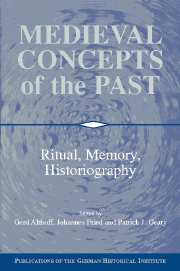Book contents
- Frontmatter
- Introduction
- 1 Authority and Legitimation of Royal Policy and Action: The Case of Henry II
- 2 King Henry II of Germany: Royal Self-Representation and Historical Memory
- 3 The Variability of Rituals in the Middle Ages
- 4 Rebels and Rituals: From Demonstrations of Enmity to Criminal Justice
- 5 Oblivion Between Orality and Textuality in the Tenth Century
- 6 Text and Ritual in Ninth-Century Political Culture: Rome, 864
- 7 The Concept of Time in the Historiography of the Eleventh and Twelfth Centuries
- 8 Constructing the Past by Means of the Present: Historiographical Foundations of Medieval Institutions, Dynasties, Peoples, and Communities
- 9 Topographies of Memory: Center and Periphery in High Medieval France
- 10 Challenging the Culture of Memoria: Dead Men, Oblivion, and the “Faithless Widow” in the Middle Ages
- 11 Artistic and Literary Representations of Family Consciousness
- 12 The Strange Pilgrimage of Odo of Deuil
- 13 The Rhineland Massacres of Jews in the First Crusade: Memories Medieval and Modern
- 14 The Martyr, the Tomb, and the Matron: Constructing the (Masculine) “Past” as a Female Power Base
- Index
9 - Topographies of Memory: Center and Periphery in High Medieval France
Published online by Cambridge University Press: 05 January 2013
- Frontmatter
- Introduction
- 1 Authority and Legitimation of Royal Policy and Action: The Case of Henry II
- 2 King Henry II of Germany: Royal Self-Representation and Historical Memory
- 3 The Variability of Rituals in the Middle Ages
- 4 Rebels and Rituals: From Demonstrations of Enmity to Criminal Justice
- 5 Oblivion Between Orality and Textuality in the Tenth Century
- 6 Text and Ritual in Ninth-Century Political Culture: Rome, 864
- 7 The Concept of Time in the Historiography of the Eleventh and Twelfth Centuries
- 8 Constructing the Past by Means of the Present: Historiographical Foundations of Medieval Institutions, Dynasties, Peoples, and Communities
- 9 Topographies of Memory: Center and Periphery in High Medieval France
- 10 Challenging the Culture of Memoria: Dead Men, Oblivion, and the “Faithless Widow” in the Middle Ages
- 11 Artistic and Literary Representations of Family Consciousness
- 12 The Strange Pilgrimage of Odo of Deuil
- 13 The Rhineland Massacres of Jews in the First Crusade: Memories Medieval and Modern
- 14 The Martyr, the Tomb, and the Matron: Constructing the (Masculine) “Past” as a Female Power Base
- Index
Summary
In the eleventh century, the Gascon abbey of Saint Sever made for itself a richly illustrated Beatus commentary on the Book of Apocalypse. A map of the world occupies two facing folios of the commentary. On it, three locations are immediately distinguishable from the plethora of tiny schematic buildings: Rome, Jerusalem, and Saint Sever. Of these three sacred places, the last is particularly highlighted, painted with more vivid shades of color and given an architectural design different from any other on the map. In this visual homology, Saint Sever is the most significant of these sacred centers of Christendom. This map thus projects an image of the world as the abbey imagined it - a world constructed around symbolic centers, of which the monastery itself is the most important.
As this eleventh-century topography demonstrates with such visual eloquence, people can read, describe, and of course shape their physical surroundings to endow them with meaning. Furthermore, as the map shows, the process of the imposition of significance on place can be intricately bound up with statements about identity – in this case, the identity of the monastic community but in others, the identity of the nation-state or of the individual. Such statements can be made verbally as well as visually, as the same Beatus manuscript demonstrates. Later in the eleventh century, a charter containing a legend about Saint Sever’s origins as a monastic community was copied onto the first of the folios, which had been left blank at the end of the Beatus manuscript.
- Type
- Chapter
- Information
- Medieval Concepts of the PastRitual, Memory, Historiography, pp. 193 - 214Publisher: Cambridge University PressPrint publication year: 2002
- 3
- Cited by

